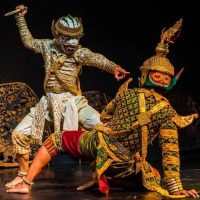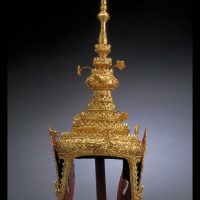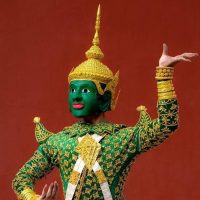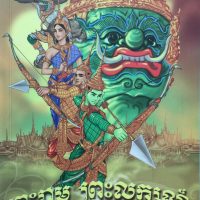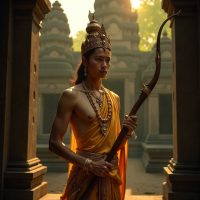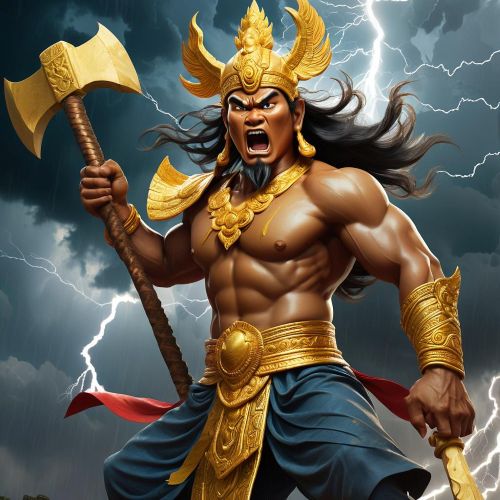Preah Ream : Cambodia’s Divine Prince and Cultural Icon
Listen
At a glance
| Description | |
|---|---|
| Origin | Cambodian Mythology |
| Classification | Gods |
| Family Members | Tosarot (Father), Kaesalya (Mother), Preah Leak, Preah Satrut (Brothers), Neang Seda (Wife) |
| Region | Cambodia |
| Associated With | Royalty, War, Virtue |
Preah Ream
Introduction
Preah Ream stands at the heart of the Reamker, the Cambodian retelling of the Ramayana that has shaped Khmer identity for centuries. Although rooted in the Indian epic, the Cambodian version transforms the story into a distinctly local expression of morality, heroism, and spiritual depth. As the prince of Ayuthea who is forced into exile, Preah Ream becomes the embodiment of righteous leadership and unwavering loyalty. His journey—marked by separation, conflict, and the restoration of order—reflects values central to Cambodian philosophy and Buddhist ethics. Through royal dance dramas, temple carvings, and literary traditions, Preah Ream continues to represent the triumph of virtue over adharma, making him an enduring symbol of cultural resilience.
Physical Traits
In Cambodian classical art and performance, Preah Ream is portrayed with a serene yet commanding presence that communicates both divinity and royal dignity. His face is often depicted with soft, symmetrical features and almond-shaped eyes that suggest wisdom and compassion. Court dancers portraying him maintain precise body lines and balanced movements, expressing his noble temperament. His attire is richly symbolic: he wears a golden mokot crown, layered silk garments, and intricate jewelry that highlight his royal lineage. Preah Ream’s physique is shown as youthful, graceful, and athletic, reflecting the idealized qualities expected of a Khmer prince and warrior. Artists frequently depict him holding a bow, emphasizing his mastery in archery and his readiness to defend righteousness.
Family
The family of Preah Ream forms the emotional and moral foundation of the Reamker. He is the son of King Tosarot and Queen Kaesalya, raised in an environment shaped by the responsibilities of kingship. His relationship with his brothers—especially Preah Leak—is central to the Cambodian narrative, where their unity underscores the values of brotherhood and loyalty. Preah Leak follows him into exile and remains his steadfast companion through hardship and conflict. Preah Ream’s wife, Neang Seda, stands as the epitome of virtue and devotion, and her abduction becomes the catalyst for the epic’s central struggle. Their bond represents the ideal marriage in Khmer tradition, deeply tied to themes of purity, sacrifice, and moral steadfastness. The tensions between family members, such as those arising from palace politics and competing loyalties, deepen the storyline and mirror the complexities of earthly duty.
Other names
Preah Ream is a Khmer adaptation of Rama, the divine hero of the Sanskrit Ramayana. Over time, he has been referred to by several names within Cambodian texts, including Preah Ram, Ream, Rama, and occasionally by titles that highlight his sacred status. The honorific “Preah” emphasizes his divinity, while “Ream” connects him to the ancient literary heritage shared across Southeast Asia. In mythological contexts, he is recognized as an incarnation of Narayama, the Khmer interpretation of Vishnu, which associates him with cosmic order and the preservation of moral balance. These variations in name reflect both the epic’s regional evolution and the layered identity Preah Ream embodies in Cambodian spirituality.
Powers and Abilities
Though Preah Ream is divine in origin, the Reamker places significant emphasis on his humanity, portraying him as a figure whose inner virtues define his greatness. His supernatural aspects are expressed subtly, through his exceptional archery, strategic intelligence, and unwavering moral clarity. His arrows are often depicted as carrying the force of divine authority, capable of defeating powerful demons and celestial adversaries. However, unlike purely mythic heroes, Preah Ream’s victories stem from discipline, self-control, and adherence to dharma. His leadership inspires loyalty in allies, from human warriors to supernatural beings such as Hanuman and the monkey army. Cambodian versions frequently highlight his integration of Buddhist principles, portraying him as compassionate, patient, and mindful, elevating him beyond the traditional warrior archetype and aligning him with the cultural and ethical values of the Khmer people.
Modern Day Influence
The legacy of Preah Ream continues to shape contemporary Cambodia in profound ways. The Reamker remains an integral part of classical Khmer ballet, where dancers preserve centuries-old techniques passed down through royal courts. These performances often reenact scenes of exile, battle, and reunion, keeping the epic alive in the cultural consciousness. Temple art across Cambodia, including at Angkor Wat, immortalizes Preah Ream in elaborate bas-reliefs, demonstrating the epic’s historical significance and its connection to national identity. In education and literature, the story of Preah Ream is used to teach moral values such as loyalty, compassion, and courage. Modern media—including animated retellings, graphic novels, and theatrical adaptations—have introduced Preah Ream to younger generations, allowing the epic to evolve while retaining its spiritual depth. His character continues to serve as a political and cultural symbol, invoked in discussions of leadership, justice, and the preservation of tradition in an increasingly modern world.
Related Images
Source
Cambodian Community Day. (2015, September 4). The Khmer Reamker overview. https://cambodiancommunityday.org/the-khmer-reamker-overview/
Wonders of Cambodia. (2025, September 21). The Reamker: Cambodia’s Epic of Good and Evil. https://wondersofcambodia.com/reamker-cambodias-epic-of-good-and-evil/
Wikipedia. (2004, April 27). Reamker. https://en.wikipedia.org/wiki/Reamker
Litlover School Blog. (2019, June 17). Reamker (A Cambodian Epic about Magic and Adventure). https://litlover.school.blog/2019/06/17/reamker-a-cambodian-epic-about-magic-and-adventure/
CID-DS. Reamker: Version of Ramayana in Cambodia. https://cid-ds.org/reamker-version-of-ramayana-in-cambodia/
Benedicte, R. (2018). Cambodian Dance: Celebration of the Gods. Bangkok: River Books. (Book)
Jacobsen, T. (2008). Lost Goddesses: The Denial of Female Power in Cambodian History. NIAS Press. (Book)
Thompson, A., & Walker, T. (2014). Performing the Ramayana Tradition: Enactments and Embodiments of Ramayana Narratives. Oxford University Press. (Publication)
Rajendran, A. (2024, October). Hanuman in Ramayana in Cambodia. Hindu Blog. https://www.hindu-blog.com/2024/10/hanuman-in-ramayana-in-cambodia.html
Bharat Ideology. (2024, January 18). Reamker: The Cambodian Adaptation of the Ramayana. https://bharatideology.com/reamker-the-cambodian-adaptation-of-the-ramayana/
Jacob, J. M. (1993). Cambodian Linguistics, Literature and History. School of Oriental and African Studies.
Pou, S. (1989). Reamker: The Cambodian Ramayana. Phnom Penh: Buddhist Institute.
UNESCO. (2003). Royal Ballet of Cambodia. Intangible Cultural Heritage. https://ich.unesco.org/en/RL/royal-ballet-of-cambodia-00108
Frequently Asked Questions
Who is Preah Ream in Cambodian mythology?
Preah Ream is the central hero of the Reamker, Cambodia’s national epic, adapted from the Indian Ramayana. He represents righteousness, virtue, and ideal kingship.
How is Preah Ream different from Rama in the traditional Ramayana?
While based on Rama, Preah Ream’s story includes distinctly Khmer elements such as Buddhist influences, local folklore, and courtly traditions, reflecting Cambodian values.
What does Preah Ream symbolize in Khmer culture?
He symbolizes moral integrity, loyalty, and the victory of good over evil, serving as an archetype of righteous leadership in Cambodian society.
Where can Preah Ream be seen in Cambodian art?
Scenes featuring Preah Ream appear in Khmer classical dance, temple murals, and bas-reliefs at Angkor Wat and other ancient sites.
Why is the Reamker important in Cambodian tradition?
The Reamker preserves cultural identity, teaches moral lessons, and remains central to performing arts, religious symbolism, and national heritage.



